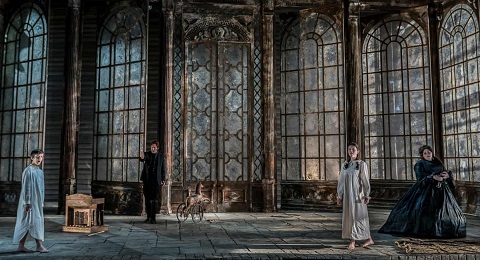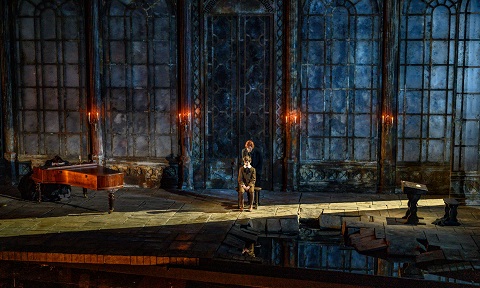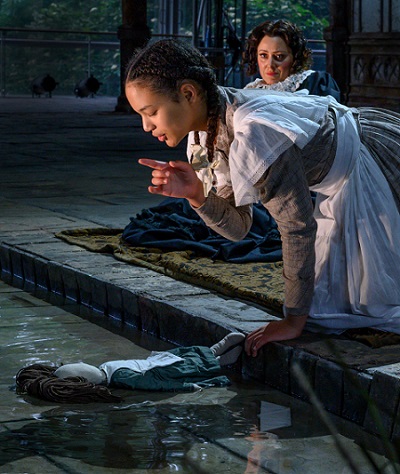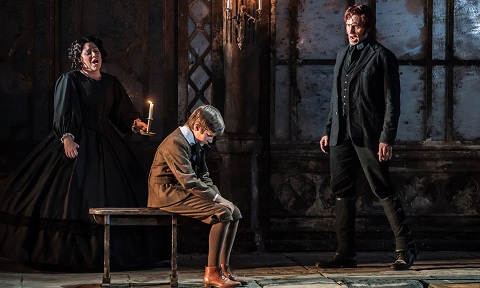
08 Jul 2019
A terrific, and terrifying, The Turn of the Screw at Garsington
One might describe Christopher Oram’s set for Louisa Muller’s new production of The Turn of the Screw at Garsington as ‘shabby chic’ … if it wasn’t so sinister.
English Touring Opera are delighted to announce a season of lyric monodramas to tour nationally from October to December. The season features music for solo singer and piano by Argento, Britten, Tippett and Shostakovich with a bold and inventive approach to making opera during social distancing.
This tenth of ten Live from London concerts was in fact a recorded live performance from California. It was no less enjoyable for that, and it was also uplifting to learn that this wasn’t in fact the ‘last’ LfL event that we will be able to enjoy, courtesy of VOCES8 and their fellow vocal ensembles (more below …).
Ever since Wigmore Hall announced their superb series of autumn concerts, all streamed live and available free of charge, I’d been looking forward to this song recital by Ian Bostridge and Imogen Cooper.
The Sixteen continues its exploration of Henry Purcell’s Welcome Songs for Charles II. As with Robert King’s pioneering Purcell series begun over thirty years ago for Hyperion, Harry Christophers is recording two Welcome Songs per disc.
Although Stile Antico’s programme article for their Live from London recital introduced their selection from the many treasures of the English Renaissance in the context of the theological debates and upheavals of the Tudor and Elizabethan years, their performance was more evocative of private chamber music than of public liturgy.
In February this year, Albanian soprano Ermonela Jaho made a highly lauded debut recital at Wigmore Hall - a concert which both celebrated Opera Rara’s 50th anniversary and honoured the career of the Italian soprano Rosina Storchio (1872-1945), the star of verismo who created the title roles in Leoncavallo’s La bohème and Zazà, Mascagni’s Lodoletta and Puccini’s Madama Butterfly.
Evidently, face masks don’t stifle appreciative “Bravo!”s. And, reducing audience numbers doesn’t lower the volume of such acclamations. For, the audience at Wigmore Hall gave soprano Elizabeth Llewellyn and pianist Simon Lepper a greatly deserved warm reception and hearty response following this lunchtime recital of late-Romantic song.
Collapsology. Or, perhaps we should use the French word ‘Collapsologie’ because this is a transdisciplinary idea pretty much advocated by a series of French theorists - and apparently, mostly French theorists. It in essence focuses on the imminent collapse of modern society and all its layers - a series of escalating crises on a global scale: environmental, economic, geopolitical, governmental; the list is extensive.
For this week’s Live from London vocal recital we moved from the home of VOCES8, St Anne and St Agnes in the City of London, to Kings Place, where The Sixteen - who have been associate artists at the venue for some time - presented a programme of music and words bound together by the theme of ‘reflection’.
'Such is your divine Disposation that both you excellently understand, and royally entertaine the Exercise of Musicke.’
Amongst an avalanche of new Mahler recordings appearing at the moment (Das Lied von der Erde seems to be the most favoured, with three) this 1991 Mahler Second from the 2nd Kassel MahlerFest is one of the more interesting releases.
‘And there was war in heaven: Michael and his angels fought against the dragon; and the dragon fought and his angels, And prevailed not; neither was their place found any more in heaven … that old serpent … Satan, which deceiveth the whole world: he was cast out into the earth, and his angels were cast out with him.’
If there is one myth, it seems believed by some people today, that probably needs shattering it is that post-war recordings or performances of Wagner operas were always of exceptional quality. This 1949 Hamburg Tristan und Isolde is one of those recordings - though quite who is to blame for its many problems takes quite some unearthing.
There was never any doubt that the fifth of the twelve Met Stars Live in Concert broadcasts was going to be a palpably intense and vivid event, as well as a musically stunning and theatrically enervating experience.
‘Love’ was the theme for this Live from London performance by Apollo5. Given the complexity and diversity of that human emotion, and Apollo5’s reputation for versatility and diverse repertoire, ranging from Renaissance choral music to jazz, from contemporary classical works to popular song, it was no surprise that their programme spanned 500 years and several musical styles.
The Academy of St Martin in the Fields have titled their autumn series of eight concerts - which are taking place at 5pm and 7.30pm on two Saturdays each month at their home venue in Trafalgar Square, and being filmed for streaming the following Thursday - ‘re:connect’.
The London Symphony Orchestra opened their Autumn 2020 season with a homage to Oliver Knussen, who died at the age of 66 in July 2018. The programme traced a national musical lineage through the twentieth century, from Britten to Knussen, on to Mark-Anthony Turnage, and entwining the LSO and Rattle too.
With the Live from London digital vocal festival entering the second half of the series, the festival’s host, VOCES8, returned to their home at St Annes and St Agnes in the City of London to present a sequence of ‘Choral Dances’ - vocal music inspired by dance, embracing diverse genres from the Renaissance madrigal to swing jazz.
Just a few unison string wriggles from the opening of Mozart’s overture to Le nozze di Figaro are enough to make any opera-lover perch on the edge of their seat, in excited anticipation of the drama in music to come, so there could be no other curtain-raiser for this Gala Concert at the Royal Opera House, the latest instalment from ‘their House’ to ‘our houses’.
"Before the ending of the day, creator of all things, we pray that, with your accustomed mercy, you may watch over us."

One might describe Christopher Oram’s set for Louisa Muller’s new production of The Turn of the Screw at Garsington as ‘shabby chic’ … if it wasn’t so sinister.
The decaying Baroque pile - foreboding pillars (perhaps an allusion to James’s phallic tower, at the top of which Peter Quint appears?); panels and glass panes that shimmer, swivel and squirm, admitting eerie presences; and doors that open, unnervingly, of their own accord - is a psychic repository of past degradation and dissolution, and present-day moral disintegration and dilapidation. This Gothic storehouse of sins, spirits and souls is lit, initially, by flickers of the early evening sun’s rays which finger the smeared, shimmering glass, and tease the eye. As darkness falls, Malcolm Rippeth’s spine-tingling lighting designs play their own tricks.
There are no ‘boundaries’: the interior and exterior of Bly diffuse into one another, trickling and infusing deceptively, like the waters of the lake that lap at the forestage shore, where Miles insouciantly sails his paper boat. The open space is, at first, sparsely populated - just a few abandoned children’s toys: a tricycle-rocking horse, a toy theatre, a hoop-and-sticks, the chalky remnants of a game of hopscotch. Innocent pastimes in which we see the children, Flora and Miles, indulge during the instrumental interludes in which the ‘screw’ theme is twisted ever tauter and tenser.
Progressively, though, the shadows deepen and stretch: illumined by guttering candles, a grand piano casts an imposing silhouette which dances disturbingly with the black forms of human figures, a school desk, as the shores of the lake shatter, and a black pool edged with crooked, crumbling paving stones forms: a stagnant, poisonous pit.
As the production unfolds, and first Miss Jessel, then Flora, and finally the Governess herself wade through the inky waters, Muller seems increasingly to be reminding us of Edmund Wilson’s debate-provoking article about James’ novella, ‘The Ambiguity in Henry James’ (which was published in The Triple Thinkers in 1948), which promoted the non-apparitionists’ cause, arguing that the ghosts were merely figures of the Governess’s hallucinations, and substantiating their claims with reference to the ‘Freudian’ symbols of the tower and the lake with which the male and female ghosts respectively are associated.
This production is a masterpiece of dramatic, and musical, pacing. As darkness literal and figurative tightens its grip, conductor Richard Farnes coaxes a panoply of conjuror’s colours from his thirteen-piece ensemble. It seems mean to single out a few players from the superb ensemble but I can’t remember a production when the clarinet, cello, bells, harp and celeste etched their utterances so compellingly: the entire instrumental voices in the pit were as inescapably provocative as the ghostly ones above.
 Ed Lyon (Peter Quint) and Leo Jemison (Miles). Photo credit: John Snelling.
Ed Lyon (Peter Quint) and Leo Jemison (Miles). Photo credit: John Snelling.
Muller’s conception of the opera’s Prologue is masterly - and not only because Ed Lyon’s Narrator sings with such directness and immediacy, every word telling, and tolling. The ‘Notes’ which Britten’s librettist Myfanwy Piper wrote, record initial plans to present an imagining of an interview between the Governess and the ‘beloved employer’ who hires her as a surrogate guardian to his young charges. Britten and Piper considered portraying the Governess’s ‘feelings of romantic love for her employer’, an incomplete draft of the libretto confirms. This idea was abandoned but the subsequent addition of the Prologue - partly for practical reasons as the opera was felt to be too short - reinstated this idea. It was decided that the description of the interview between the Governess and the children’s guardian would be delivered indirectly by a Narrator (an equivalent of ‘Douglas’ in James’s tale, who introduces the ghost story to the country house guests). The roles of the Narrator and Peter Quint would be sung by the same singer, thereby directly involving the audience in the opera’s moral dilemma.
Muller’s ‘take’ on this conceit is ingenious. Ed Lyon, dressed in a formal day suit, invites the audience to hear his “curious story”; at which point Sophie Bevan’s Governess, cloaked in a voluptuous identity-erasing crinoline, arrives and listens to, then seems to interacts, with the Narrator’s recollections. The result is that, as the Governess looks yearningly at the Narrator and waits for the approval and instructions which seem to be delivered directly to her, the ‘him’ of the narration becomes an imagined ‘I’, the past and present become blurred. It makes her subsequent encounters and battles with Peter Quint, whose red wig and knee-high black boots do little to disguise his likeness to the Narrator-cum-Guardian, all the more ambiguous and troubling.
 Adrianna Forbes-Dorant (Flora) and Sophie Bevan (Governess). Photo credit: John Snelling.
Adrianna Forbes-Dorant (Flora) and Sophie Bevan (Governess). Photo credit: John Snelling.
This is a superb interpretation of the Governess by Bevan. At the start, her soprano rings with the fresh brightness of new starts and new relationships: she certainly is James’s ‘young’, ‘untried’ and ‘nervous’ young girl, excited by the ‘space and air and freedom, all the music of summer and all the mystery of nature’ which Bly will offer her. Even the timpani jolts which disturb her journey to Bly don’t sound too foreboding: she wants the children to “show me everything”, Bevan declares in a voice which shines with anticipation. Then, suddenly, when she reads a letter telling her that Miles has been dismissed from his school, Bevan’s visage and voice crumble in dismay, fear and confusion. But, it’s not long before she is charged with her mission: she must, “See what I see, know what I know, that they may see and know nothing”, her soprano trailing off into a fragile pianissimo which hints at mental disintegration. When facing her alter ego, Miss Jessel, this Governess burns fiercely; when writing the letter to the children’s guardian - “there are things you must know … Forgive me” - Bevan’s soprano is sensuously soft; the energy which ripples through her playful games with the children acquires an edge of panic when she chastises or pleads with them. This Governess is every bit James’s ‘impressionable young girl’ whose nature reflects ‘her anxieties and inductions’. And, at the climax of her destructive battle with Peter Quint, Bevan garners a formidable power, her soprano vibrant with the validity of the Governess’s self-assumed ‘authority’.
Adrianna Forbes-Dorant and Leo Jemison are brilliant as her young charges, Flora and Miles. Waiting excitedly for their new Governess’s arrival at Bly they practise their bows and curtsies with ever more extravagant flourishes. Their innocent pastimes perhaps hint at darker concerns though: Flora takes the large leather ball they throw between them and places it beneath her white dress, thrusting her stomach out in imitation pregnancy; when the Governess routs Miles in mock-swordplay and the boy falls to the floor, its difficult not to see Miles’s prone figure as a foreshadowing of the damage she is destined to wreak. Later, the children hide under the piano, then don ghastly masks and leap out to harry their tormented tutor.
Jemison’s ‘knowing’ delivery of the ‘Malo Song’ is disquietingly confident and poised: the clever but boisterous little boy who learns his Latin declensions so skilfully, suddenly becomes absolutely, unnervingly, motionless, his seated form facing forward, his glance slanting sideways, fixed with unwavering intensity on his Governess as the strange song etches its eerie shapes in the still air.
Forbes-Dorant’s Flora, warm and strong of voice, seems to be full of good-hearted mischief as she gambols and goads the Governess. But, her geography lesson turns ghoulish when she christens the lake at Bly as ‘The Dead Sea’ - “They call it dead because nothing can live in it,” explains the Governess. Taking her rag doll from its pram, Flora cradles and strokes it for a moment, before plunging it violently into the water: raising the dripping doll, she proffers it - a sacrificial effigy of ghastly limpness - towards an unknown, unseen force, her arms outstretched, her eyes transfixed and glowing with fury. It’s horrifying.
 Sophie Bevan as the Governess, Leo Jemison as Miles and Ed Lyon as Quint. Photo credit: Johan Persson.
Sophie Bevan as the Governess, Leo Jemison as Miles and Ed Lyon as Quint. Photo credit: Johan Persson.
The Ghosts in this production would give neither of the two sides in the critical debate surrounding James’s novella - the ‘literalists’ (literary scholars such as Leon Edel, Allen Tate and Robert Heilman) and the Freudians (led by Edmund Wilson) - a clear ‘victory’. Finely balanced between the real or imagined, here Peter Quint and Miss Jessel are very much ‘present’, though it’s impossible to be certain whether they literally walk the corridors at Bly or simply stalk the troubled dreams of the Governess.
Overcome with fear that “They are lost! Lost”, the Governess falls to the floor in a hysterical faint. With the her prone figure on stage throughout Quint’s nocturnal bewitchment of Miles, we wonder whether his seductive song might not be simply her fervid imaginings? But, we see and hear it too, don’t we? And, Lyon’s mesmeric melismas are no ethereal crooning, but rather a strong and muscular, and beautiful, call-to-arms. What young boy would not be impressed, charmed, corrupted? When Mrs Grose rushes in to rouse Flora from the latter’s own night-time ramblings, the Governess awakes and finds herself alone in the garden with Miles. Staring squarely at the Governess, he taunts, in the purest tone, “You see, I am bad. I am bad, aren’t I?”, his hand outstretched, beckoning. Who is tempting whom?
Katherine Broderick’s Miss Jessel clearly regrets submitting to Quint’s temptations; with almost Wagnerian resonance, she flings fierce, quasi-hysterical, accusations at her cold, unmoved seducer, wracked with a despair born of unrequited love, shame and sexual passion. Kathleen Wilkinson’s Mrs Grose is a wonderful, and welcome, foil to such toxic energies.
As so, what of the ending? To which of the two forces in the battle for his ‘possession’ will Miles address his response to the Governess’s question, “Who do you wait for, watch for?”? In the event Muller stays true to the ambiguity that she has sustained throughout. At first, it seems, as Quint retreats and the Governess cradles the collapsed boy in the folds of her crinoline, that the victory is hers. But, Muller has a final surprise in store. The Governess may have convinced herself that she has ‘saved’ Miles - “I caught him, yes, I held him - it may be imagined with what a passion” says James’s Governess - but her passion is a destructive deadening counterpart to Quint’s imaginative creativity. And, in the final moments she seems to realise this, and her growing identification with the ghosts, particularly with Miss Jessel, overcomes her. She rises, and as the lights extinguish, she literally follows in her predecessor’s footsteps, walking slowly through the black waters, across and beyond the Garsington pavilion.
Muller preserves and communicates all of indeterminacy of James’s pervasive evil. In his ‘Preface’ to the tale, James writes, ‘There is no eligible … absolute of the wrong; it remains relative to fifty other elements, a matter of appreciation, speculation, imagination … Only make the reader’s general vision of evil intense enough, I said to myself - and that is already a charming job - and his own experience, his own imagination, his own sympathy … will supply him quite sufficiently with all the particulars. Make him think the evil, make him think it for himself, and you are released from weak specifications.’ Muller certainly makes her audience ‘think’ the evil ‘for themselves’. There are no moral absolutes, and the result is both terrifying and transfixing.
Claire Seymour
Britten: The Turn of the Screw
Prologue/Quint - Ed Lyon, Governess - Sophie Bevan, Flora - Adrianna Forbes-Dorant, Miles - Leo Jemison, Mrs Grose - Kathleen Wilkinson, Miss Jessel - Katherine Broderick; Director - Louisa Muller, Conductor - Richard Farnes, Designer - Christopher Oram, Lighting Designer - Malcolm Rippeth, Garsington Opera Orchestra.
Garsington, Worsley: Sunday 7th July 2019.